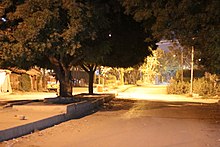Limited overs cricket, also known as one-day cricket or white ball cricket, is a version of the sport of cricket in which a match is generally completed in one day. There are a number of formats, including List A cricket, Twenty20 cricket, and 100-ball cricket. The name reflects the rule that in the match each team bowls a set maximum number of overs, usually between 20 and 50, although shorter and longer forms of limited overs cricket have been played.
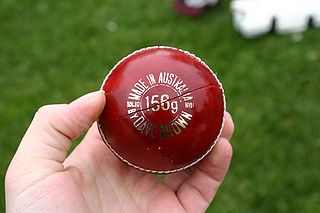
A cricket ball is a hard, solid ball used to play cricket. A cricket ball consists of a cork core wound with string then a leather cover stitched on, and manufacture is regulated by cricket law at first-class level. The trajectory of a cricket ball when bowled, through movement in the air, and off the ground, is influenced by the action of the bowler and the condition of the ball and the pitch, while working on the cricket ball to obtain optimal condition is a key role of the fielding side. The principal method through which the batter scores runs is by hitting the ball, with the bat, into a position where it would be safe to take a run, or by directing the ball through or over the boundary. Cricket balls are harder and heavier than baseballs.

Wasim Akram is a Pakistani cricket commentator, coach, and former cricketer and captain of the Pakistan national cricket team. Akram is regarded as one of the greatest bowlers of all time. He is often revered as The Sultan of Swing. In October 2013, Wasim Akram was the only Pakistani cricketer to be named in an all-time Test World XI to mark the 150th anniversary of Wisden Cricketers' Almanack. As captain, he led Pakistan to the finals of the 1999 Cricket World Cup, where they lost to Australia by 8 wickets. He was a part of the Pakistani squad which won the 1992 Cricket World Cup.

Mohammad Sami is a Pakistani cricket coach and former cricketer who played for the Pakistan national cricket team between 2001 and 2016.

Waqar Younis Maitla HI is a Pakistani cricket coach, commentator and former cricketer who captained Pakistan national cricket team. A right-arm fast bowler, he is regarded as one of the greatest bowlers in cricket. He is the former head coach of the Pakistani cricket team. He was a part of the squad which finished as runners-up at the 1999 Cricket World Cup.
Sarfraz Nawaz Malik is a former Pakistani Test cricketer and politician, who was instrumental in Pakistan's first Test series victories over India and England. Between 1969 and 1984, he played 55 Tests and 45 One Day Internationals and took 177 Test wickets at an average of 32.75. He is known as one of the earliest exponents of reverse swing.

Tennis ball cricket (Softball Cricket) is a variant of cricket played using a tennis ball. It is popular in the Indian subcontinent and is also played in Middle-East, United States, Canada, Australia and Europe. A tennis ball is easier to play with compared to a conventional hard cricket ball and is also less likely to cause injury. There is no definite record as to when this originated in the Indian subcontinent.
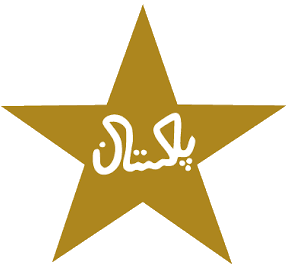
The history of cricket in Pakistan predates the creation of the country in 1947. The first international cricket match in what is now Pakistan today was held in Karachi on 22 November 1935 between Sindh and Australia. The match was seen by 5,000 Karachiites. Cricket was introduced by the British during their colonial rule of British India, which covered the area now known as Pakistan. Cricket is the most popular sport in the country. The Pakistan Cricket Board controls all domestic cricket in Pakistan and the national teams. Pakistan is an official member of the International Cricket Council and the Asian Cricket Council. Regarded as one of the best and most passionate cricketing nations, Pakistan has won the Cricket World Cup in 1992, ICC T20 World Cup in 2009, the ICC Champions Trophy in 2017, the ICC Under-19 Cricket World Cup in 2004 and 2006, the ACC Asia Cup in 2000 and 2012. Pakistan were runner ups in the 1999 Cricket World Cup and 2007 and 2022 T20 World Cups. Pakistan have also been runner ups in several Asia Cup editions.

Wahab Riaz is a Pakistani cricket administrator and former cricketer who was the incumbent chief selector of Pakistan national cricket team from 17 November 2023 until 24 March 2024, and is an advisor to the chief minister of Punjab for sports and youth affairs, in the caretaker government headed by Mohsin Raza Naqvi.
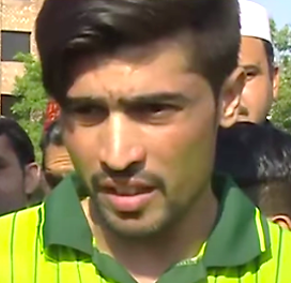
Mohammad Amir is a Pakistani cricketer who is playing for the Pakistan national cricket team. He is a left-arm fast bowler and a left handed batsman. He retired from international cricket in 2020 aged 28 but on 24 March 2024 he took his retirement back and made his availability for the Pakistan cricket team. He was a member of the Pakistan team that won the 2009 ICC World Twenty20 and 2017 ICC Champions Trophy.
Nahida Bibi Khan is a Pakistani former cricketer who played as a right-handed batter, and occasional right-arm medium-fast bowler and wicket-keeper. She played for Pakistan, and has played domestic cricket for Quetta, Balochistan, Saif Sports Saga and Zarai Taraqiati Bank Limited. On 15 June 2023, she announced her retirement from international cricket.

Kainat Imtiaz is a Pakistani cricketer who plays as an all-rounder, batting right-handed and bowling right-arm medium-fast, for Pakistan. She has also played domestic cricket for Karachi, Sindh, Omar Associates, Saif Sports Saga, State Bank of Pakistan and Zarai Taraqiati Bank Limited. She is daughter of umpire Saleema Imtiaz.
Usman Khan Shinwari is a professional Pakistani cricketer. He is a left-arm fast bowler who plays for the Zarai Taraqiati Bank Ltd cricket team (ZTBL) in Pakistan's first-class cricket circuit. He has also previously played for the Khan Research Laboratories cricket team (KRL). In December 2013, he bowled ZTBL to victory in the national T20 final with impressive figures of 5 wickets for 9 runs in four overs. He was subsequently picked for the national side in the T20 series against Sri Lanka in the UAE.
Imran Khan is a Pakistani cricketer who made his Twenty20 debut for the Peshawar Panthers during the 2014–15 season of the Haier T20 Cup. He is a left-arm fast bowler, known for "bamboozl[ing] opposing batsmen" through his "repertoire of slower balls". He made his Twenty20 International debut against Zimbabwe on 27 September 2015.

Mohammad Rizwan is a Pakistani international cricketer who is the current vice-captain of the Pakistan cricket team in T20I cricket and captains Pakistan Super League (PSL) franchise Multan Sultans. He is a wicket-keeper batsman.

Hasan Ali is a Pakistani cricketer who plays for the national team in all formats. He made his first-class debut for Sialkot in October 2013. He made his international debut for Pakistan in August 2016 in a One Day International (ODI) match. The following summer, he was named in Pakistan's squad for the 2017 ICC Champions Trophy. Pakistan went on to win the tournament with Ali named player of the tournament after taking thirteen wickets, and took the final wicket of Jasprit Bumrah. He became the quickest bowler for Pakistan to take 50 wickets in ODIs. In August 2018, he was one of thirty-three players to be awarded a central contract for the 2018–19 season by the Pakistan Cricket Board (PCB).
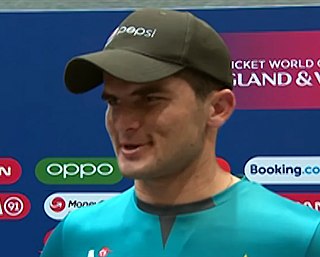
Shaheen Shah Afridi is a Pakistani international cricketer and the former captain of the Pakistan national cricket team in the T20I format. He captains the Lahore Qalandars in the PSL. Under his leadership, Lahore Qalandars won their first PSL title in the 2022 season and again went on to win the 2023 season, becoming the first team in PSL history to successfully defend their title. He is the first Pakistani to win the Garfield Sobers Trophy.
Mohammad Hasnain is a Pakistani cricketer who has played for the Pakistan cricket team since 2019. He is one of the fastest bowlers currently, timed at over 150kmh.
Fatima Sana is a Pakistani cricketer who plays primarily as a right-arm medium-fast bowler for Pakistan. She has played domestic cricket for Karachi, Zarai Taraqiati Bank Limited, Barbados Royals and Canterbury Magicians. In April 2019, she was named in Pakistan's squad for their series against South Africa. She made her Women's One Day International (WODI) debut for Pakistan against South Africa on 6 May 2019. She made her Women's Twenty20 International (WT20I) debut for Pakistan against South Africa on 15 May 2019. In January 2020, she was named in Pakistan's squad for the 2020 ICC Women's T20 World Cup in Australia. In December 2020, she was shortlisted as one of the Women's Emerging Cricketer of the Year for the 2020 PCB Awards.
Saim Ayub is a Pakistani cricketer who plays for Pakistan national cricket team and for Karachi Whites in domestic cricket. He made his international debut in T20 against Afghanistan Afghanistan Cricket Board, on 24 March 2023 and made his test debut vs Australia Australia cricket In the 3rd test on 3 January. He has been a regular member in T20 since his debut

